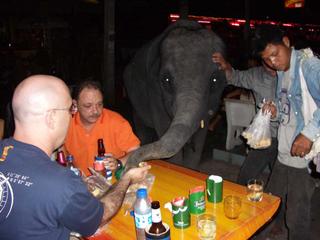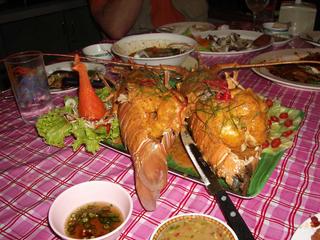
Pattaya Bay
Eoy were eating dinner at a restaurant on the Walking Street. Our table was on a pier over the water. At sunset, the lights on the boats in the bay came on and made a picture-perfect moment.

Elephant in a bar
It isn't the beginning of a joke. There really was an elephant in the bar. Jeff, Todd and I were having a drink at the Buffalo Bar on Soi 7, when the elephant and his mahout visited us -- A dictionary published by the Thai Royal Institute indicates the mahout is defined as being a person who drives, takes care of and controls elephants

Ronald McDonald says, "Sawatdee Khrab"
The wai is the Thai greeting and show of respect, indicated by pressing your palms together near your chest and bowing. Sawatdee Khrab (or Sawatdee Kaa if you are female) is how Thais say hello. At this McDonald's on Beach Road in Pattaya, Ronald McDonald greets you at the front of the restaurant.

Fruit and Vegetable Carving
Kae-sa-luk, the art of Thai fruit and vegetable carving is one particularly delightful aspect of Thai cuisine. In the fruit carver's skilled hands and using a small and very sharp pointed knife, an ordinary papaya or pumpkin is turned into a bouquet of flowers, a radish becomes a tiny rabbit or daisy or a carrot a rare orchid. Almost any kind of fruit or vegetable can be used. The carver must understand the texture of each and use its natural colour to imitate that of the chosen subject. Not all the carvings are as small as a flower; a large round watermelon becomes a richly decorated and lidded bowl to be used as a container for fruit salad. The green outer skin is cut away to make a pattern in relief of flowers or even characters in Thai literature.

Gigantic Lobsters!
In Chiang Mai, we had a dinner that included the largest curried lobster I ever saw. It was one of the specials of the day, and we had no idea it was going to be so enormous! On the platter containing the monstrous lobsters was a carving of a rooster from a carrot. The detail was unbelievable. It is hard to image the orange rooster was once a carrot!

Traditional Thai Dance
The two major forms of Thai classical dance drama are khon and lakon nai. In the beginning both were exclusively court entertainments, and it was not until much later that a popular style of dance theatre, likay, evolved as a diversion for the common folk who had no access to royal performances.
Music is integral to all forms of Thai dance drama and khon and lakon nai performances are accompanied by an orchestra comprising traditional instruments -- usually five percussion pieces and one woodwind. Small bell-like cymbals are used to set the pace while the music of the rest of the orchestra lends mood.
Students of khon learn four categories -- male human, female human (usually played by male dancers), demonic and simian. Each has its own style of movement and before training begins students are selected according to which parts they are best suited.

Students of lakon nai must memorize the mae bot, the 'mother alphabet of dance' which contains 64 basic gestures and patterns or movement, before learning how to combine these in interpretive dancing that tells a story

Song-taew
The song-taew (literally, "two planks") is Pattaya's equivalent to a taxi. It is a pick up truck with two benchs in the bed of the truck. They continually ply the Beach Road and Pattaya 2 Road in counterclockwise circuits, but can be hired to take you to other locations. It isn't uncommon to see a song-taew over-flowing with people -- People sometimes stand on the rear step and hold on to the rails as the song-taew makes it's way through the traffic.

Pattaya Beach
This is a photograph of Pattaya Beach in the early afternoon.
No comments:
Post a Comment